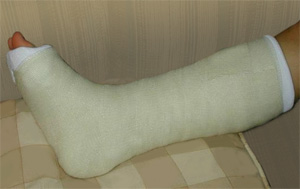Backslab versus Full Cast?
These terms refer to whether a cast extends partially (Backslab) or entirely around the limb (Full Cast). An injured arm or leg is likely to swell up shortly after the traumatic event for several reasons. It is also likely that the limb may continue to swell up, particularly if left hanging downwards. This is why we usually recommend elevating the limb (see RICE). Because of this unpredictable swelling, applying a backslab is a safe option.
This involves casting one side of the limb and combining this with a soft dressing around the limb to splint the injury. It temporarily prevents excess movement at the injury site and compresses the limb to help prevent further swelling thus helping in treating pain. If further swelling can be anticipated after surgery on a limb, similarly the backslab can be indicated here also.
At the orthopaedic clinic, if a fracture has been diagnosed, then the backslab can be exchanged for a full cast. This is a more robust and reliable method of splinting a fracture.
Fibreglass Versus Plaster?
These terms refer to the materials used to make the cast. Plaster of Paris is heavier, easier to mould into the shape needed and can expand slightly if tight. Fibreglass is lighter, stiffer and retains the tight shape that it takes when first applied. Depending on the fracture site, shape and presence of limb swelling will often determine the type of cast that is applied.
